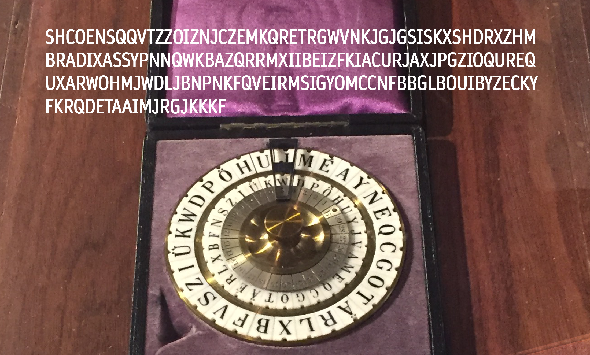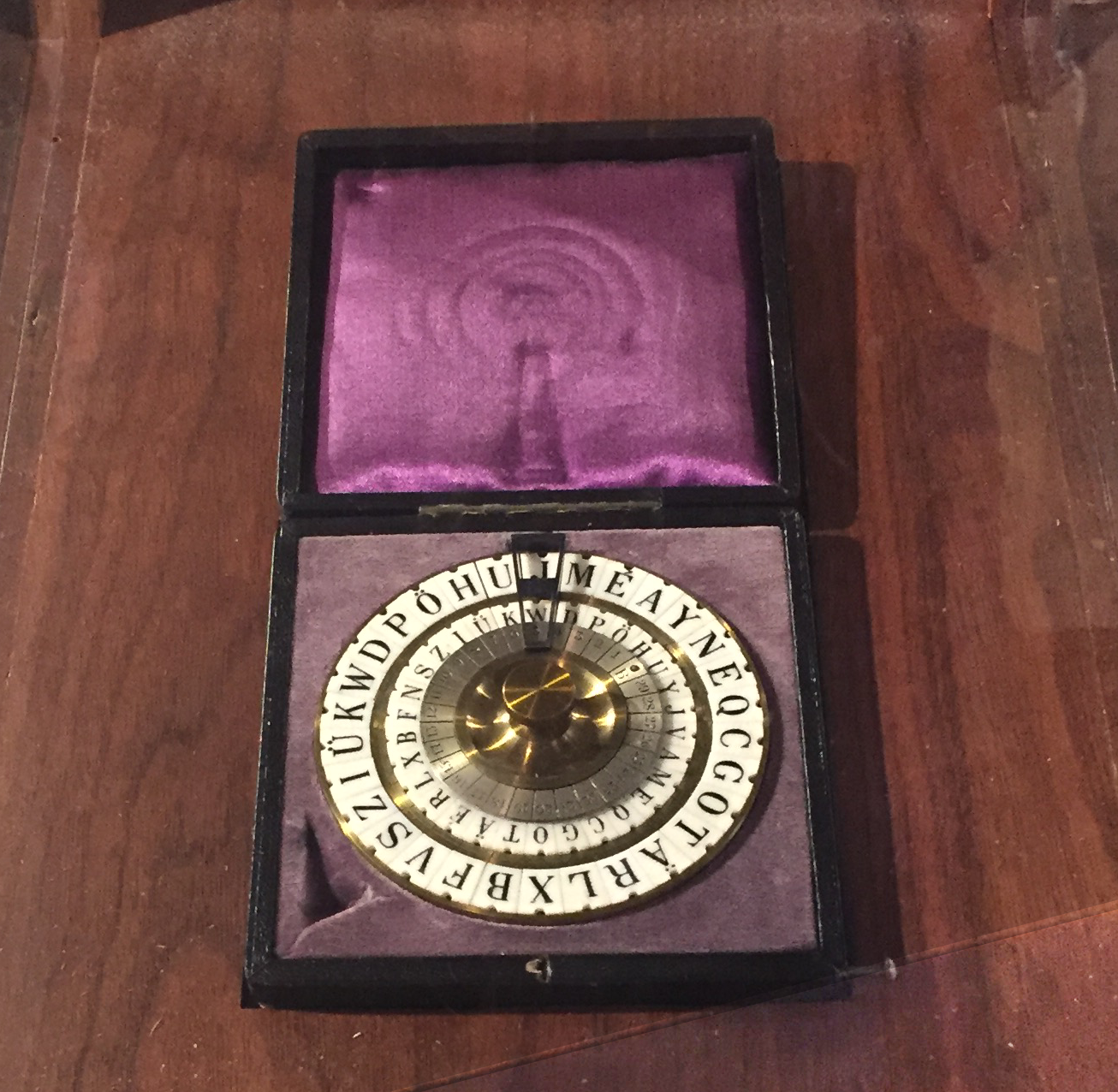The Friedman Ring Challenge by George Lasry
Three months ago, George Lasry solved Christoph Tenzer’s challenge and is thus the current bearer of the Friedman Ring. Today I present George’s new challenge. Whoever solves it will be his successor.
The first person to solve the current crypto puzzle creates the next one. The Friedman Ring works according to this simple principle. It is a game named after the cryptologists William and Elizebeth Friedman. It is modeled on the Iffland Ring, which has been awarded to actors for centuries.
Three months ago, the fourth round of the Friedman Ring game ended. The last puzzle so far came from Christoph Tenzer. George Lasry was the first to solve it and thus became the new bearer of the Friedman Ring.
This results in the following list of carriers:
- Frank Schwellinger
- Anna Salpingidis und Christoph Tenzer
- Armin Krauß
- Christoph Tenzer
- George Lasry
There is a web page on the progress to date. The respective recipient of the Friedman ring commits himself to develop a crypto puzzle and to make it available to me. Whoever solves this puzzle first will be the new bearer.
The Wheatstone Disk
Today we have the new challenge. For this, I would first like to briefly explain what a Wheatstone disk is. It is an encryption tool from the 19th century:
A Weatstone disk consists of two concentric letter disks. A template shows the plaintext letter at the top and the ciphertext letter at the bottom. After encrypting one letter, the disk is rotated to the next. The number of letters on the inner and outer disks are different, resulting in a shift in each case.
Let’s look at an example George sent me. Given a Wheatstone disk with the following inscription (the number of letters is 27 on the outside, 26 on the inside):
- Plaintext Disk Alphabet: ABCDEFGHIJKLMNOPQRSTUVWXYZ_ – start position: F
- Ciphertext Disk Alphabet: SYPQVTRMXJCNFKZDUIOHEBWALG – start position: C
As you can see, the letters on the plaintext disk are in alphabetical order, while those on the ciphertext disk are not. The plaintext is now the following: TO_BE_OR_NOT_TO_BE. George’s software now outputs the following (the positions of the disk start with 0):
| Plaintext Disk: F ( 5) | Cipher Disk: C (10) Encrypt: T | Moving: 14 Steps | Plaintext Disk: T (19) | Cipher Disk: L (24) | T => L Encrypt: O | Moving: 22 Steps | Plaintext Disk: O (14) | Cipher Disk: E (20) | O => E Encrypt: _ | Moving: 12 Steps | Plaintext Disk: _ (26) | Cipher Disk: R ( 6) | _ => R Encrypt: B | Moving: 2 Steps | Plaintext Disk: B ( 1) | Cipher Disk: X ( 8) | B => X Encrypt: E | Moving: 3 Steps | Plaintext Disk: E ( 4) | Cipher Disk: N (11) | E => N Encrypt: _ | Moving: 22 Steps | Plaintext Disk: _ (26) | Cipher Disk: M ( 7) | _ => M Encrypt: O | Moving: 15 Steps | Plaintext Disk: O (14) | Cipher Disk: W (22) | O => W Encrypt: R | Moving: 3 Steps | Plaintext Disk: R (17) | Cipher Disk: G (25) | R => G Encrypt: _ | Moving: 9 Steps | Plaintext Disk: _ (26) | Cipher Disk: X ( 8) | _ => X Encrypt: N | Moving: 14 Steps | Plaintext Disk: N (13) | Cipher Disk: W (22) | N => W Encrypt: O | Moving: 1 Steps | Plaintext Disk: O (14) | Cipher Disk: A (23) | O => A Encrypt: T | Moving: 5 Steps | Plaintext Disk: T (19) | Cipher Disk: P ( 2) | T => P Encrypt: _ | Moving: 7 Steps | Plaintext Disk: _ (26) | Cipher Disk: J ( 9) | _ => J Encrypt: T | Moving: 20 Steps | Plaintext Disk: T (19) | Cipher Disk: Q ( 3) | T => Q Encrypt: O | Moving: 22 Steps | Plaintext Disk: O (14) | Cipher Disk: G (25) | O => G Encrypt: _ | Moving: 12 Steps | Plaintext Disk: _ (26) | Cipher Disk: N (11) | _ => N Encrypt: B | Moving: 2 Steps | Plaintext Disk: B ( 1) | Cipher Disk: K (13) | B => K Encrypt: E | Moving: 3 Steps | Plaintext Disk: E ( 4) | Cipher Disk: U (16) | E => U
So the encrypted message reads: LERXNMWGXWAPJQGNKU
Let’s look at another example. This time the pane has the following inscription (the number of letters is again 27 outside, 26 inside):
- Plaintext Disk Alphabet: TOJPFGXYZENRUCQKBWMHVID_ALS – start position: G
- Ciphertext Disk Alphabet: SYPQVTRMXJCNFKZDUIOHEBWALG – start position: C
So the letters are not sorted alphabetically on both disks. The software outputs the following:
| Plaintext Disk: G ( 5) | Cipher Disk: C (10) Encrypt: T | Moving: 22 Steps | Plaintext Disk: T ( 0) | Cipher Disk: R ( 6) | T => R Encrypt: O | Moving: 1 Steps | Plaintext Disk: O ( 1) | Cipher Disk: M ( 7) | O => M Encrypt: _ | Moving: 22 Steps | Plaintext Disk: _ (23) | Cipher Disk: Q ( 3) | _ => Q Encrypt: B | Moving: 20 Steps | Plaintext Disk: B (16) | Cipher Disk: A (23) | B => A Encrypt: E | Moving: 20 Steps | Plaintext Disk: E ( 9) | Cipher Disk: I (17) | E => I Encrypt: _ | Moving: 14 Steps | Plaintext Disk: _ (23) | Cipher Disk: T ( 5) | _ => T Encrypt: O | Moving: 5 Steps | Plaintext Disk: O ( 1) | Cipher Disk: C (10) | O => C Encrypt: R | Moving: 10 Steps | Plaintext Disk: R (11) | Cipher Disk: E (20) | R => E Encrypt: _ | Moving: 12 Steps | Plaintext Disk: _ (23) | Cipher Disk: R ( 6) | _ => R Encrypt: N | Moving: 14 Steps | Plaintext Disk: N (10) | Cipher Disk: E (20) | N => E Encrypt: O | Moving: 18 Steps | Plaintext Disk: O ( 1) | Cipher Disk: F (12) | O => F Encrypt: T | Moving: 26 Steps | Plaintext Disk: T ( 0) | Cipher Disk: F (12) | T => F Encrypt: _ | Moving: 23 Steps | Plaintext Disk: _ (23) | Cipher Disk: J ( 9) | _ => J Encrypt: T | Moving: 4 Steps | Plaintext Disk: T ( 0) | Cipher Disk: K (13) | T => K Encrypt: O | Moving: 1 Steps | Plaintext Disk: O ( 1) | Cipher Disk: Z (14) | O => Z Encrypt: _ | Moving: 22 Steps | Plaintext Disk: _ (23) | Cipher Disk: C (10) | _ => C Encrypt: B | Moving: 20 Steps | Plaintext Disk: B (16) | Cipher Disk: V ( 4) | B => V Encrypt: E | Moving: 20 Steps | Plaintext Disk: E ( 9) | Cipher Disk: L (24) | E => L
This time the encrypted text reads: RMQAITCEREFFJKZCVL.
For those who want to know more, George sent me the following links:
- Book by Willam Friedman with a chapter on the Wheatstone disk (p. 187).
- Book by Lambros Callimahos with a chapter (Chapter VIII) about the Wheatstone disk
- Challenge on MysteryTwister with one sorted (plaintext) and one unsorted (ciphertext) inscription, like in the first example
George Lasry’s cryptogram
George’s Friedman ring challenge was encrypted with a Wheatstone disk in which both letter rings are not in alphabetical order. The number of letters is 27 on the outside, 26 on the inside. Here is the encrypted text:
SHCOE NSQQV TZZOI ZNJCZ EMKQR
ETRGW VNKJG JGSIS KXSHD RXZHM
BRADI XASSY PNNQW KBAZQ RRMXI
IBEIZ FKIAC URJAX JPGZI OQURE
QUXAR WOHMJ WDLJB NPNKF QVEIR
MSIGY OMCCN FBBGL BOUIB YZECK
YFKRQ DETAA IMJRG JKKKF
Will a reader find the solution? The Friedman ring is already waiting to be handed over by George to the next reader.
Admittedly, I would not have thought of creating a challenge based on the Wheatstone disk, because actually this encryption tool is considered insecure. However, if you don’t know the order of the letters, it gets tricky. So I’m curious to see if any readers crack the cipher. Hill climbing, the super algorithm of code breaking, is not likely to work here easily.
As often mentioned, one of the disadvantages of such a challenge is that every reader hint that is published as a comment can help another codebreaker to win. So I ask my readers not to be so selfish. If there is discussion about solutions in the forum, it makes things more exciting for everyone. Of course, I will acknowledge every comment that contributed to the solution accordingly.
The race is on!
If you want to add a comment, you need to add it to the German version here.
Follow @KlausSchmeh
Further reading: Christoph’s Chaotic Caesar Challenge
Linkedin: https://www.linkedin.com/groups/13501820
Facebook: https://www.facebook.com/groups/763282653806483/





Letzte Kommentare